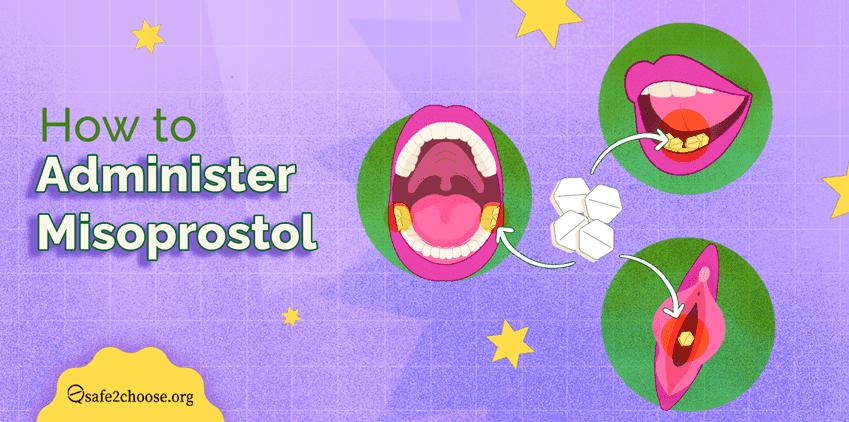The abortion pill is widely used to terminate a pregnancy. The abortion pill allows individuals to end a pregnancy at home or in another environment of their choice. It does not require a hospital visit or supervision by a healthcare provider. Additionally, it works roughly 95 to 99 percent of the time. Therefore, it is an effective and convenient option for patients seeking an abortion1.
How does the abortion pill work?
The abortion pill consists of two different types of medication: mifepristone and misoprostol. These two medications have different mechanisms that work together to terminate a pregnancy.
Mifepristone
Mifepristone works by altering a hormone known as progesterone. Progesterone is the main hormone involved in preparing the body for pregnancy. Progesterone acts on the endometrium, which is the tissue that lines the uterus. With higher progesterone levels, the endometrium thickens, creating an environment that can accommodate a pregnancy. From there, a fertilized egg can implant itself in the thicker endometrial lining, stay there, and develop.
Mifepristone acts by blocking progesterone. In doing so, the endometrial lining breaks down. Disruption of the endometrium prevents the egg from implanting and surviving, thus ending the pregnancy2.
Misoprostol
Misoprostol is the second medication included in the “abortion pill”. After Mifepristone ends the pregnancy, Misoprostol empties the uterus. It does so by activating receptors in the uterus, thus increasing the frequency and strength of contractions. The stronger contractions help expel the tissue. This phase works similarly to a miscarriage, as it can cause heavy cramping1,3,4.
What do I need to do before I take the abortion pill?
Ending a pregnancy can be challenging both physically and emotionally. Therefore, there are a few things you should consider before taking the abortion pill:
- Situate yourself in a safe and comfortable environment. Taking the abortion pill often causes discomfort, such as heavy cramping and bleeding. A private location where you feel secure can remove some of the stressors associated with having an abortion.
- Consider having a support system with you. In addition to the physical symptoms, familial, cultural, and societal stigma associated with abortion can make the process emotionally draining. Having someone with you that is understanding and supportive may be beneficial.
- Have tools available to help manage your symptoms. As aforementioned, medication abortion can lead to discomfort. Taking medication such as a nonsteroidal anti-inflammatory drug (NSAID), e.g. Ibuprofen, or Tylenol can help manage pain symptoms. Do not take Aspirin as it can make bleeding worse. You can take a pain reliever around 30 minutes prior to taking misoprostol, the second abortion medication. A heating pad can also provide relief. You should also have a supply of regular pads available to you, as you will likely experience heavy bleeding.
- Allow yourself time to rest. Abortion pill side effects can last between one to three days, depending on when you took each medication. Therefore, ensure you block out time to manage your symptoms, rest, and recover5.
What happens during a medication abortion?
The abortion pill works in two steps. Mifepristone prevents the pregnancy from further developing, while Misoprostol works by emptying the uterus of its contents.
After taking Mifepristone and Misoprostol, when will the bleeding start?
After taking Mifepristone, most individuals do not have symptoms, though some can experience light bleeding. In general, strong cramping and bleeding starts within about 4-6 hours after taking misoprostol. But, it can start as soon as 30 minutes after taking misoprostol, but it might take up to 24 hours to begin. Bleeding resembles a very heavy and crampy period. You may see large blood clots or tissue clumps, which can be different sizes depending on how far along the pregnancy was. After 10 weeks, you might see or feel a recognizable embryo or fetus when it passes. Your body usually finishes expelling the pregnancy tissue after four to five hours, but it may last longer. Bleeding should typically slow down after the pregnancy tissue is out, but it can last for several days. If you do not experience bleeding within 24 hours of taking Misoprostol, contact your healthcare provider or our counseling team.
In the weeks following the abortion, it is normal to continue to have some bleeding and spotting, even until your next menstrual period, usually happening within 4-6 weeks. You can manage the bleeding with a pad, tampon, or menstrual cup. Using pads, however, can help you track how much you are bleeding6.
How does a medication abortion feel?
Besides bleeding, the other main symptom of a medication abortion is cramping. Cramping, like bleeding, can last for several hours and slows down after expulsion of the pregnancy tissue. Cramping, however, can persist intermittently for another day or two.
Different people will have different reactions to the abortion pill. Other common side effects of the abortion pill that you may experience include:
- Stomach discomfort and/or vomiting
- Diarrhea
- Fatigue
- Dizziness
- Mild fever and chills
- Breast tenderness and leakage
Fever, nausea, and chill symptoms should resolve relatively quickly. However, if your symptoms of fever, nausea, vomiting, or diarrhea persist for greater than 24 hours after taking the final pill the last dose of misoprostol, seek medical attention. These could be signs of infection.
As mentioned before, pain relievers and a heating pad can help minimize pain. Other ways to relieve side effects can include:
- Taking anti-nausea medication
- Having someone rub your back
- Taking a shower
- Sitting on the toilet
As soon as you are feeling better, you may resume your normal activities such as working or exercising.
In addition to the physical symptoms of the abortion pill, many individuals will experience a wide range of emotions after undergoing an abortion. While some will experience feelings of relief, others may experience regret or sadness. This is completely normal, however, if your mood is affecting your day-to-day life, consider talking to a mental health professional6.


